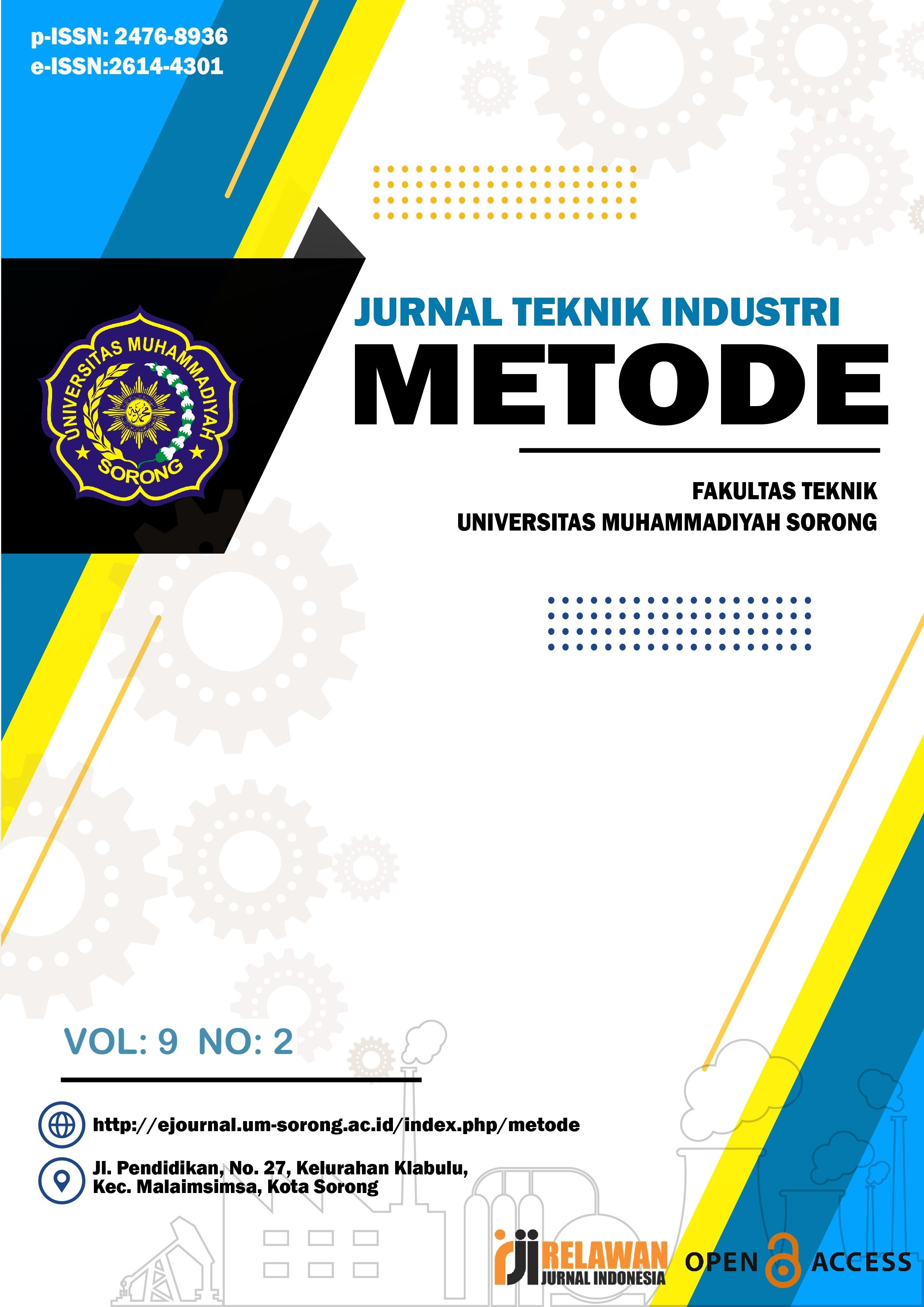Implementasi BPOMM Dalam Mengevaluasi Level Kematangan Proses Bisnis UMKM
Keywords:
BPOMM, Model Kematangan, Proses Bisnis, Tingkat KematanganAbstract
Improving MSME business performance is highly dependent on the level of business process maturity. The higher the level (level) of maturity (Integrated) of a business's business processes, the more stable and able to achieve competitive advantage. Vice versa, if the maturity level of business processes is at a low level (ad hoc), it will have implications for the stability and inability of the Company to achieve competitive advantage. For this reason, this study aims to adopt the Business Process Orientation Maturity Model framework in assessing the performance of MSMEs through the business maturity process. This research is based on a case study by making UMKM East Kampoeng and Abon Layur Amiroh Salted Fish located in Balikpapan city as research objects. This study uses the business process orientation maturity model (BPOMM) as a model framework and 4 (four) business process maturity levels as a reference for evaluating business process maturity levels. The process of collecting data through the distribution of questionnaires that have been validated by experts and SMEs. While data analysis consists of calculating the assessment results and comparing aspects of business process maturity. The results of the study show that through the BPOMM model framework, the maturity level of the UMKM business processes in East Kampoeng and Shredded Salted Fish Amiroh is at the second level or "Defined". To reach the highest level or "Integrated" the two MSMEs must consistently and irrationally improve aspects of business process maturity that are considered lacking based on recommendations
References
Andriani, M., Samadhi, T. M. A. A., Siswanto, J., & Suryadi, K. (2018). Aligning business process maturity level with SMEs growth in Indonesian fashion industry. International Journal of Organizational Analysis, 26(4), 709–727. https://doi.org/10.1108/IJOA-08-2017-1215
Becker, J., Knackstedt, R., & Pöppelbuß, J. (2009). Developing Maturity Models for IT Management. Business & Information Systems Engineering, 1(3), 213–222. https://doi.org/10.1007/s12599-009-0044-5
Dewi, F., & Mahendrawathi, E. R. (2019). Business process maturity level of MSMEs in East Java, Indonesia. Procedia Computer Science, 161, 1098–1105. https://doi.org/10.1016/j.procs.2019.11.221
Dijkman, R., Vincent, S., & Ad, L. (2016). Properties that influence business process management maturity and its effect on organizational performance. Information Systems Frontiers, 717–734. https://doi.org/10.1007/s10796-015-9554-5
Harmon, P. (2016). A BPTrends Report: The State of Business Process Management 2016. A BPTrends Report, 1–52. http://www.bptrends.com/bpt/wp-content/uploads/2015-BPT-Survey-Report.pdf
Hung, R. Y. Y. (2006). Business Process Management as competitive advantage: A review and empirical study. Total Quality Management and Business Excellence, 17(1), 21–40. https://doi.org/10.1080/14783360500249836
https://www.gerbangumkmborneo.com/
Kosidin, Setiawan, W., & Dirgantari, P. D. (2020). Analisis Kajian Manajemen Proses Bisnis Penelitian Dan Pengabdian Kepada Masyarakat. Jurnal Ilmu Manajemen Dan Bisnis Islam, 5(1), 77–91. http://jurnal.iain-padangsidimpuan.ac.id/index.php/attijaroh
Kurnia, W. I., Kisanjani, A., & Kurnia, R. (2023). Penilaian Tingkat Kematangan Proses Bisnis Pada Usaha Mikro, Kecil dan Menengah: (Studi Kasus). Jurnal Surya Teknika, 10(1), 668–675. https://doi.org/10.37859/jst.v10i1.4972
Lacerda, T. C., & von Wangenheim, C. G. (2018). Systematic literature review of usability capability/maturity models. Computer Standards and Interfaces, 55, 1339–1351. https://doi.org/10.1016/j.csi.2017.06.001
McCormack, K. P., & Johnson, W. C. (2001). Business Process Orientation. Business Process Orientation, September. https://doi.org/10.4324/9780367815608
Mccormack, K., Willems, J., Bergh, J. Van Den, Deschoolmeester, D., Willaert, P., Štemberger, I., Škrinjar, R., Trkman, P., Ladeira, M. B., De, M. P. V., Mccormack, K., Willems, J., Bergh, J. Van Den, Deschoolmeester, D., & Willaert, P. (2009). A global investigation of key turning points in business process maturity. Business Process Management Journal, 15(5), 792–815.
Okręglicka, M., Mynarzová, M., & Kaňa, R. (2015). Business process maturity in small and medium-sized enterprises. Polish Journal of Management Studies, 12(1), 121–131.
Ongena, G., & Ravesteyn, P. (2020). Business process management maturity and performance: A multi group analysis of sectors and organization sizes. Business Process Management Journal, 26(1), 132–149. https://doi.org/10.1108/BPMJ-08-2018-0224
Oxford English Dictionary. (2004). The Definitive Record of the English Language. Oxford University Publisher
Poeppelbuss, J., Niehaves, B., Simons, A., & Becker, J. (2011). Maturity Models in Information Systems Research: Literature Search and Analysis. Communications of the Association for Information Systems, 29. https://doi.org/10.17705/1cais.02927
Pradita, T. A. (2021). Perancangan Risk Maturity Model Berdasarkan ISO 31000:2018 Pada Perusahaan di Indonesia. 1–106.
Röglinger, M., Pöppelbuß, J., & Becker, J. (2012). Maturity models in business process management. Business Process Management Journal, 18(2), 328–346. https://doi.org/10.1108/14637151211225225
Rohloff, M. (2009). Case study and maturity model for business process management implementation. Lecture Notes in Computer Science (Including Subseries Lecture Notes in Artificial Intelligence and Lecture Notes in Bioinformatics), 5701 LNCS, 128–142. https://doi.org/10.1007/978-3-642-03848-8_10
Rosianti, N. C., & ER, M. (2017). Analisis Tingkat Kematangan Proses Bisnis Dan Kesiapan Teknologi Informasi Studi Kasus Usaha Garmen Mikro, Kecil, Dan Menengah Di Jawa Timur. Jurnal Teknik ITS, 6(2), 264–269. https://doi.org/10.12962/j23373539.v6i2.23160
Serenko, A., Bontis, N., & Hull, E. (2016). An application of the knowledge management maturity model: the case of credit unions. Knowledge Management Research and Practice, 14(3), 338–352. https://doi.org/10.1057/KMRP.2014.37
Shi, X., Baba, T., Osagawa, D., Fujishima, M., & Ito, T. (2019). A Maturity Model for Sustainable System Implementation in the Era of Smart Manufacturing. IEEE International Conference on Emerging Technologies and Factory Automation, ETFA, 2019-Septe, 1649–1652. https://doi.org/10.1109/ETFA.2019.8869446
Škrinjar, R., Vukšić, V., & Štemberger, M. (2010). Adoption of Business Process Orientation Practices: Slovenian and Croatian Survey. Bsrj, 1(1–2), 5–19. https://doi.org/10.2478/v10305-012-0022-0
Tarhan, A., Turetken, O., & Reijers, H. A. (2016). Business process maturity models: A systematic literature review. Information and Software Technology, 75, 122–134. https://doi.org/10.1016/j.infsof.2016.01.010
van Looy, A., de Backer, M., & Poels, G. (2011). Defining business process maturity. A journey towards excellence. Total Quality Management and Business Excellence, 22(11), 1119–1137. https://doi.org/10.1080/14783363.2011.624779
Vásquez, J., Aguirre, S., Puertas, E., Bruno, G., Priarone, P. C., & Settineri, L. (2021). A sustainability maturity model for micro, small and medium-sized enterprises (MSMEs) based on a data analytics evaluation approach. Journal of Cleaner Production, 311(August 2020). https://doi.org/10.1016/j.jclepro.2021.127692
Viegas, R. A., & Costa, A. P. C. S. (2023). Assessing business process orientation using multi-criteria decision-making. Business Process Management Journal, 29(2), 352–368. https://doi.org/10.1108/BPMJ-07-2022-0357
Downloads
Published
How to Cite
Issue
Section
License
Copyright (c) 2023 Wahyu Ismail Kurnia, Rosna Kurnia, Muhamad Hasyim Tuankotta, Alex Kisanjani

This work is licensed under a Creative Commons Attribution-ShareAlike 4.0 International License.









